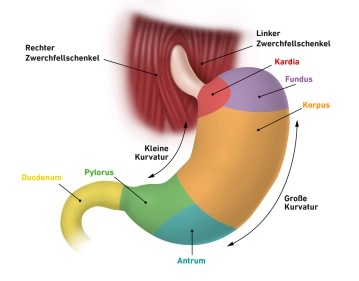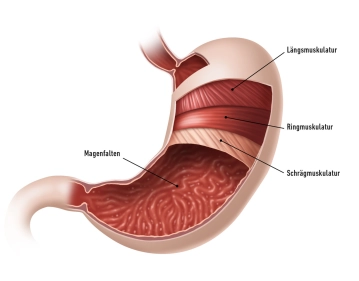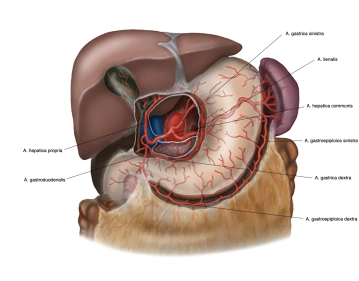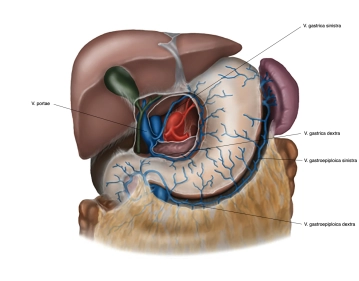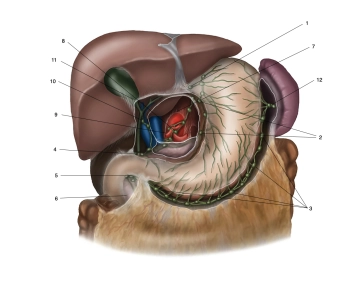The stomach is a muscular hollow organ located between the esophagus and duodenum, situated in the left and central upper abdomen directly beneath the diaphragm. When moderately filled, it is 25 – 30 cm long and has a storage capacity of 1.5 liters, which can extend up to 2.5 liters in extreme cases. The position, size, and shape of the stomach vary greatly depending on age, filling state, and body position, with significant interindividual differences.
The stomach is divided into the following sections:
- Cardia (Gastric Entrance, Upper Gastric Orifice, Ostium cardiacum):
The cardia is a 1–2 cm region where the esophagus transitions into the stomach. The sharp junction between the esophageal and gastric mucosa, often visible endoscopically, marks this area
- Fundus gastricus (Gastric Fundus):
Located above the gastric entrance, the fundus arches upward, also known as the gastric dome or Fornix gastricus. It is usually filled with air swallowed involuntarily during eating. In an upright position, the fundus forms the highest point of the stomach, and the collected air appears as a “gastric bubble” in radiographic images. It is separated from the cardia by a distinct fold, the Incisura cardialis
- Corpus gastricum (Gastric Body):
The main part of the stomach, the corpus, features deep longitudinal mucosal folds (Plicae gastricae), extending from the cardia to the pylorus. These folds are also referred to as the “gastric road”
- Pylorus (Pars pylorica, Gastric Pylorus):
This section begins with the expanded Antrum pyloricum, followed by the pyloric canal (Canalis pyloricus), and ends with the pylorus itself. The pylorus contains the pyloric sphincter (M. sphincter pylori), a thick circular muscle that closes the lower gastric orifice (Ostium pyloricum), allowing periodic passage of chyme into the duodenum
The stomach is intraperitoneal, covered by serosa except for the dorsal cardia. The embryonic mesogastria rotate from a sagittal to a frontal position during development:
- The Omentum minus extends from the lesser curvature to the liver hilum
- The Omentum majus extends from the greater curvature to the transverse colon, spleen, and diaphragm
The stomach is located intraperitoneally, which gives it a serosal covering, except for the posterior portion of the cardia, which lacks serosa. During embryonic development, the mesogastria undergo a rotation from their original sagittal orientation to a frontal position. The omentum minus extends from the lesser curvature to the porta hepatis, while the omentum majus spreads out from the greater curvature to the transverse colon, spleen, and diaphragm.
The stomach is anchored and stabilized within the abdominal cavity by ligaments that extend to the liver and spleen. Its convex side forms the greater curvature (greater gastric curvature/curvatura major), while its concave side creates the lesser curvature (lesser gastric curvature/curvatura minor). The anterior wall is referred to as the paries anterior, and the posterior wall as the paries posterior. The greater curvature gives rise to the omentum majus, and the omentum minus stretches between the left liver lobe and the lesser curvature.

